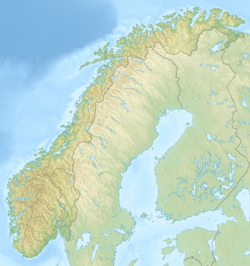Galdhøpiggen
| Galdhøpiggen | |
|---|---|

Galdhøpiggen viewed from the west (Fannaråki)
|
|
| Highest point | |
| Elevation | 2,469 m (8,100 ft) |
| Prominence | 2,372 m (7,782 ft) |
| Isolation | 1,568.3 kilometres (974.5 mi) |
| Listing |
Country high point Ultra |
| Coordinates | 61°38′12″N 8°18′54″E / 61.63667°N 8.31500°ECoordinates: 61°38′12″N 8°18′54″E / 61.63667°N 8.31500°E |
| Geography | |
| Location | Lom, Oppland, Norway |
| Parent range | Jotunheimen |
| Topo map | 1518 II Galdhøpiggen |
| Climbing | |
| First ascent | 1850 (Steinar Sulheim, S. Flaatten and L. Arnesen) |
| Easiest route | Hike |
Galdhøpiggen is the highest mountain in Norway, Scandinavia and Northern Europe, at 2,469 m (8,100 ft) above sea level. It is located within the municipality of Lom (in Oppland), in the Jotunheimen mountain area.
Galdhøpiggen (Norwegian pronunciation: [ˈɡɑldhøːˌpɪgən]) means "the peak/spike () of the mountain Galdhø." The first element in the name of the mountain is (m.) "steep mountain road", the last element is (f.) "(big and) rounded mountain." An old road between Gudbrandsdalen and Sogn passes beneath the mountain.
Geologically Galdhøpiggen, like most of Southern Norway's mountain ranges, belongs to the Caledonian folding. The peak is made of gabbro, a hard but rather coarse-grained rock which is found in most of the Jotunheimen range. During the ice ages it was heavily glaciated and got its present form. The theory that the highest summits in Norway stayed above the ice as nunataks has been abandoned by most geologists. It fits well with the present flora in the area, but it does not fit well with the present knowledge of ice thickness and the results of glaciation.
For many years, geologists did not know that Galdhøpiggen was the highest summit in Norway. The honor was granted to the much more visible Snøhetta in the Dovrefjell range. Hence no attempts were made to climb the peak, while Snøhetta was visited for the first time in 1798 as part of a scientific trip to the area. In 1844 the geologist and mountaineer, Baltazar Mathias Keilhau, made two unsuccessful attempts to reach the summit. On one of these he reached a summit, which was later named Keilhaus topp, (at 2,355 m above sea level very close to Galdhøpiggen), but the terrible weather forced him to return.
...
Wikipedia

